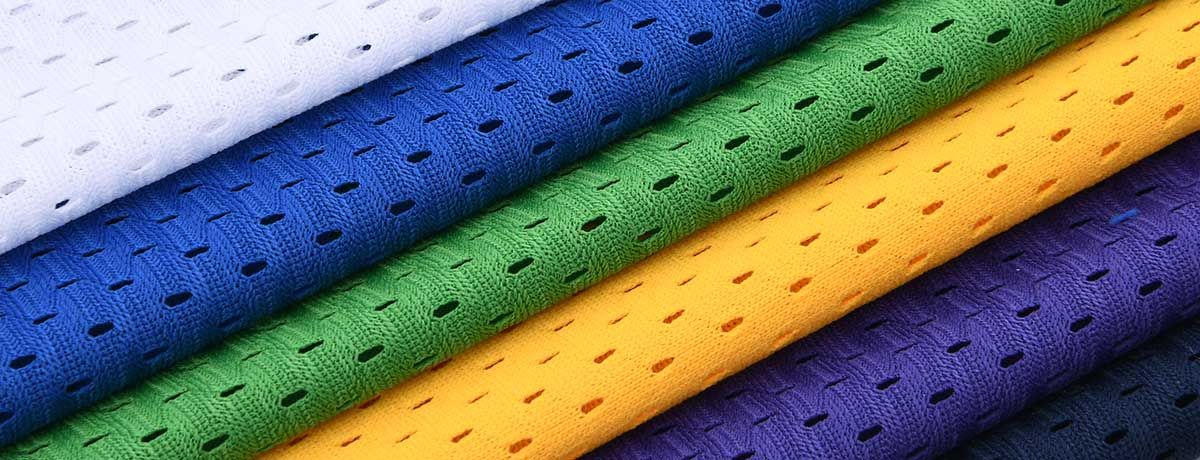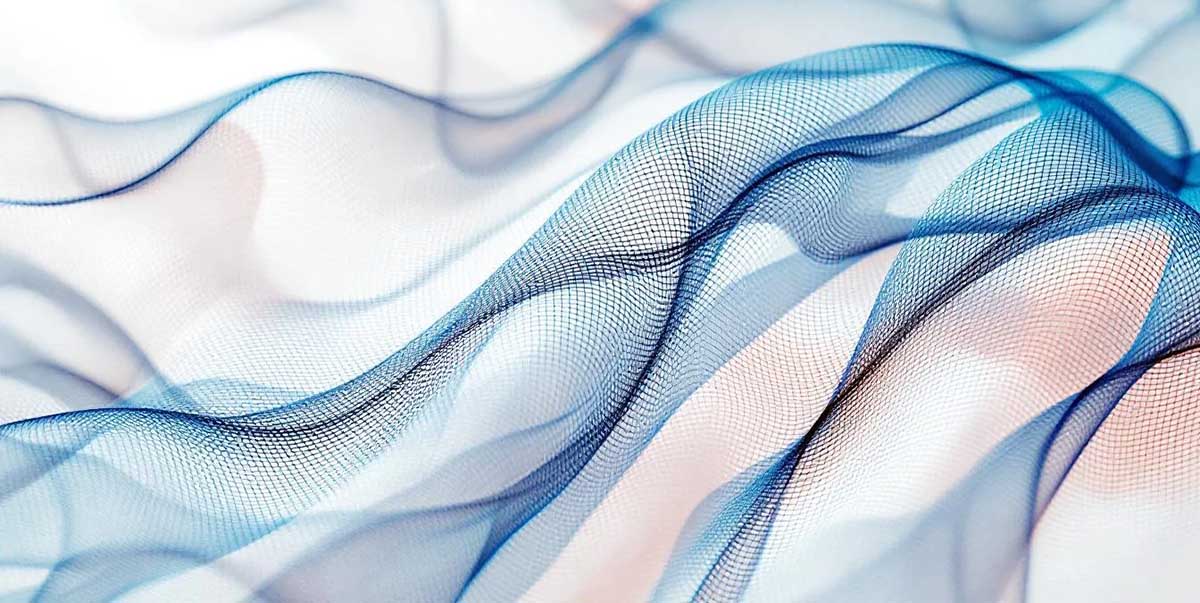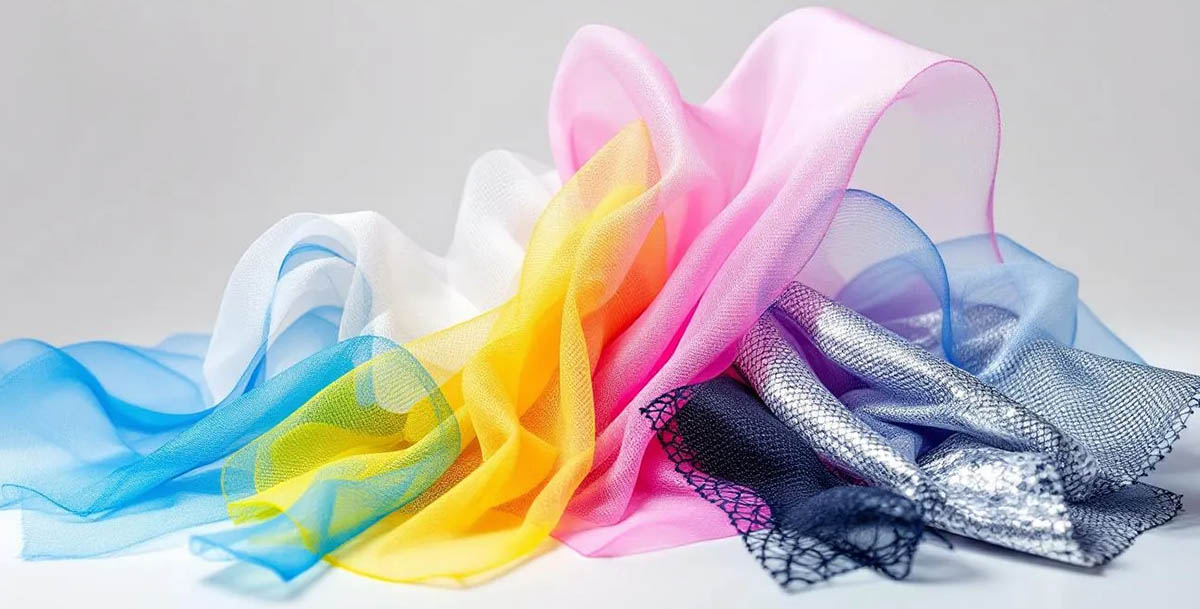Top Uses and Benefits of Mesh Fabric for Your Projects

- Key Takeaways
- Understanding Mesh Fabric
- How Mesh Fabric Is Made
- Common Durable Types of Mesh Fabric
- Popular Outdoor Applications of Mesh Fabric
- Environmental Impact of Mesh Fabric
- Certifications for Mesh Fabric
- Price and Cost Factors of Mesh Fabric
- Choosing the Right Mesh Fabric for Your Project
- Care and Maintenance of Mesh Fabric
- Innovative Uses of Mesh Fabric in Modern Design
- Creative Projects and DIY Ideas with Mesh Fabric
- Summary
- Frequently Asked Questions
Looking to understand mesh fabric? It’s a breathable, lightweight fabric ideal for sportswear, lingerie, and industrial uses. Learn about its making, types, and applications, and discover why it’s a go-to material for many projects.
Key Takeaways
-
Mesh fabric is characterized by its breathable, moisture-wicking properties and has evolved from its historical use in nets to significant applications in fashion and sportswear.
-
The production process of mesh fabric involves intricate steps from petroleum extraction to weaving, and the environmental impact is a growing concern due to its non-biodegradable materials and energy-intensive manufacturing.
-
Choosing the appropriate mesh fabric requires evaluating factors such as durability, environmental sustainability, and specific project requirements to ensure optimal functionality and performance.
Understanding Mesh Fabric

The concept of mesh fabric is far from new; its origins can be traced back thousands of years when it was primarily used for making nets. However, the late 1800s marked a significant turning point when Aertex, founded by Lewis Haslam, began manufacturing mesh fabric specifically for clothing. This innovation opened the door to a myriad of applications, particularly in the world of fashion and sportswear.
Mesh fabric is distinguished by:
-
Its loose weave, which creates thousands of tiny holes
-
A unique structure that enhances breathability, making it ideal for garments that keep the wearer cool and comfortable
-
High moisture-wicking properties that contribute to its popularity, especially in activewear where staying dry during intense physical activity is crucial
Early adoption of mesh fabric in apparel was driven by these very properties. Athletes and fitness enthusiasts quickly embraced the lightweight and breathable nature of mesh, setting the stage for its widespread use in sportswear. Today, mesh fabric continues to evolve, finding new applications and pushing the boundaries of fashion and functionality.
How Mesh Fabric Is Made
The journey of creating mesh fabric begins with:
-
Extraction and refining of petroleum oil, a fundamental step in producing both nylon and polyester meshes.
-
Extraction of polyamide monomers from the refined petroleum, forming the building blocks of the fabric.
-
Chemical reaction of these monomers with acid, resulting in solid polymers.
-
Melting of the solid polymers and pushing them through spinnerets to form fine strands.
Before these strands can be woven into the fabric, they typically undergo a dye process. Dyeing is an essential step, as it allows for the creation of vibrant and varied colors, ensuring that the final product meets aesthetic and functional requirements. The dyed fibers are then woven using different patterns, each tailored to produce a specific type of mesh fabric.
The main materials used in making mesh fabric are nylon and polyester, both derived from petroleum-based polymers. The diverse weaving techniques employed can yield unique textures and patterns, enhancing the versatility of mesh fabric. This intricate production process underscores the complexity and precision involved in creating a material that is both functional and aesthetically pleasing.
Common Durable Types of Mesh Fabric

The term ‘mesh’ encompasses a variety of fabrics, each with distinct weaving patterns and applications. One of the most popular types is polyester mesh, known for its lightweight, moisture-wicking, and breathable properties, making it a favorite in athletic wear. Power mesh, on the other hand, is celebrated for its compression abilities, making it a staple in shapewear.
Powernet, with its denser weave, is predominantly used in shaping garments like bras and control slips. Its structure provides the necessary support and durability required for these applications. Nylon mesh, another common type, finds its use in various domains, including beekeeping veils, laundry bags, and lightweight clothing. Its versatility and strength make it suitable for a wide range of practical uses.
Tulle, often associated with colorful dance costumes, is typically made from synthetic materials and is known for its delicate and airy appearance. Each type of mesh fabric is suited for specific projects, with variations in strength, breathability, and flexibility. Contemporary weaving techniques further enhance the versatility of mesh fabric, allowing for unique textures and patterns to be achieved.
Popular Outdoor Applications of Mesh Fabric
Mesh fabrics have carved a niche in the world of sportswear, where their breathable and lightweight nature significantly enhances comfort during workouts. Athletes and fitness enthusiasts rely on mesh garments to stay cool and dry, making it an indispensable part of their gear. The high moisture-wicking properties of mesh fabric make it ideal for this purpose, ensuring that the wearer remains comfortable even during intense physical activity.
Mesh fabric is also commonly used in lingerie. Its delicate and sheer properties make it perfect for creating intimate apparel that is both comfortable and visually appealing. Shapewear also benefits from mesh fabric, which provides a comfortable fit while maintaining a smooth and flattering silhouette. The flexibility and breathability of mesh fabric make it a preferred choice in these applications.
Beyond clothing, mesh fabric has various industrial applications. It is used in netting for fishing, providing a strong yet lightweight solution for catching fish. Screen printing, another industrial use, employs mesh fabric to apply designs onto surfaces, showcasing its versatility and utility. The adaptability of mesh fabric across different domains highlights its importance and widespread use.
Environmental Impact of Mesh Fabric
The environmental impact of mesh fabric is a topic of growing concern. Both nylon and polyester, the primary materials used in mesh fabric, are not biodegradable. This means they persist in ecosystems for potentially thousands of years, contributing to long-term pollution. When disposed of, these materials reenter the environment, exacerbating the issue of non-biodegradability.
The production of nylon and polyester involves the use of petroleum, a non-renewable resource that significantly contributes to environmental degradation. The manufacturing process of mesh fabrics is energy and water-intensive, often resulting in the contamination of water sources that are returned to the environment. These processes not only deplete essential resources but also have a detrimental effect on surrounding ecosystems.
Additionally, the creation of nylon involves the emission of nitrous oxide, a greenhouse gas that is significantly more harmful than carbon dioxide. The energy-intensive nature of nylon production further amplifies its environmental footprint. Overall, the environmental impact of petroleum-based mesh fabrics is negative, posing significant challenges for sustainability.
Certifications for Mesh Fabric
Certifications play a crucial role in promoting sustainable practices in the textile industry. The Global Recycled Standard (GRS) is one such certification that:
-
Focuses on verifying recycled textile content
-
Ensures that products meet strict social and environmental criteria during production
-
Requires a minimum of 50% recycled content, setting a higher standard than the Recycled Claim Standard (RCS).
Organizations seeking GRS certification must undergo third-party audits to ensure compliance with the set standards throughout the supply chain. This rigorous process ensures transparency and accountability, allowing certified organizations to use the GRS logo.
This logo serves as a signal to consumers that the products adhere to high recycling and environmental standards.
Price and Cost Factors of Mesh Fabric
The cost of mesh fabric is influenced by several factors, including the type of material used, the weave style, and the production location. Countries like China, India, Pakistan, and Indonesia are often mentioned as more cost-effective sources for mesh fabric, owing to their lower production costs. The choice of material, whether synthetic or natural, also plays a significant role in determining the price.
Factors affecting the cost of silk tulle and similar fabrics include:
-
The cost of raw materials and complexity of the production process, making silk tulle generally more expensive than synthetic options.
-
The thickness and density of the fabric, with denser fabrics requiring more material and thus costing more.
-
Quality levels and production processes, where superior materials and meticulous craftsmanship in high-quality variants lead to higher costs.
Global economic conditions and market demand further influence the price of mesh fabric. Fluctuations in the global economy can affect raw material costs, labor charges, and overall production expenses, ultimately impacting the final price of mesh fabric.
Choosing the Right Mesh Fabric for Your Project
Selecting the right mesh fabric for your project involves considering several key factors. Durability is paramount, especially for high-use applications where the fabric needs to withstand wear and tear. For projects requiring movement, such as activewear, flexibility in the fabric is essential to enhance comfort and performance.
Environmental considerations are increasingly important when choosing mesh fabric. Key factors to consider include:
-
Opting for recycled materials to help mitigate the ecological impact of your project.
-
Considering the thickness and density of the fabric, as these influence both functionality and cost.
-
Understanding the specific requirements of your project to choose the most suitable type of mesh fabric.
Quality levels and production processes also play a significant role in the selection process. Higher-quality variants may come at a higher cost but offer superior performance and longevity. By thoroughly considering these factors, you can make a well-informed choice and select the mesh fabric that best suits the needs of your project.
Care and Maintenance of Mesh Fabric
Proper care and maintenance are essential to prolong the lifespan of mesh fabric items. For best results:
-
Hand-wash mesh fabric or use a gentle cycle in the washing machine.
-
Avoid using harsh chemicals, as they can damage the delicate fibers of the fabric.
-
Treat stains immediately to prevent them from setting and becoming harder to remove.
Storing mesh items properly is also important. Folding or hanging mesh garments can help avoid wrinkles and damage. Regularly brushing mesh products with a soft-bristled brush can remove dirt and prevent pilling, keeping the fabric in good condition.
Following these care tips will ensure that your mesh fabric items remain in excellent shape for a long time.
Innovative Uses of Mesh Fabric in Modern Design
Mesh fabric has found its way into modern design, showcasing its versatility and innovative applications. In home decor, mesh curtains allow natural light to filter through while providing privacy, making them perfect for warmer climates. Stylish table runners and overlays made from mesh fabric add texture and visual interest to dining settings.
Wall art crafted from mesh fabric can create a three-dimensional effect, enhancing the aesthetic appeal of contemporary spaces. In addition, durable mesh storage solutions are another innovative use, as they maintain airflow and prevent moisture accumulation, making them ideal for various storage needs.
The adaptability of mesh fabric in modern design underscores its easy potential for creative and functional applications.
Creative Projects and DIY Ideas with Mesh Fabric
Mesh fabric opens up a world of creative possibilities for DIY enthusiasts and makers, thanks to its durable structure, easy handling, and affordable price. Whether you’re looking to enhance your outdoor space or craft unique decorative items, mesh fabric is a go-to material that’s both practical and inspiring.
For outdoor projects, polyethylene mesh fabric is a top choice. Its ability to withstand cold weather and resist the elements makes it ideal for creating garden screens, plant covers, or custom netting for landscaping. These outdoor items not only protect your plants but also add a functional and stylish touch to your garden. Mesh netting is easy to cut to size and attach to frames, allowing you to create custom solutions for your space without breaking the bank.
If you’re interested in home decor, mesh fabric offers a creative way to make lamp shades, room dividers, or even wall art. By stretching mesh over a frame or combining it with wood, you can create pieces that play with light and shadow, adding a modern effect to any room. In addition, mesh fabric takes dye well, so you can personalize your projects with vibrant colors or subtle hues to match your style.
Crafters and sewing enthusiasts will appreciate how easy it is to handle mesh fabric when making bags, purses, or even lightweight clothing. Its flexibility and strength mean your handmade items will stand up to regular use. When you choose a high-quality mesh, you ensure your creations are both attractive and long-lasting.
For those who love to experiment, mesh fabric can be used to create sculptural art pieces. Stretch it over a frame, paint or dye it, and watch as it transforms into a one-of-a-kind artwork. The open weave of mesh fabric allows for interesting visual effects and the addition of other materials, making it a favorite for mixed-media projects.
On this page, you’ll find a wide selection of mesh fabric products, including durable polyethylene mesh and versatile nylon mesh, all commonly shipped directly to your door. Our products are sold at competitive prices, and our easy-to-use cart system makes it simple to add items and complete your order. Whether you’re making outdoor netting, decorative home items, or wearable art, you’ll find the right mesh fabric to bring your ideas to life. Choose from our high-quality products and start creating your next project the easy way!
Summary
Mesh fabric is a versatile and innovative material that has found applications across various domains, from fashion and sportswear to industrial uses and modern design. Its unique properties, such as breathability and moisture-wicking, make it an ideal choice for many projects. However, it is important to consider the environmental impact and choose sustainable options when possible.
By understanding the different types of mesh fabric, their applications, and how to care for them, you can make informed decisions and leverage the benefits of this incredible material. Whether you are a designer, an athlete, or simply someone interested in innovative textiles, mesh fabric offers endless possibilities for creativity and functionality.
Frequently Asked Questions
What are the main types of mesh fabric, and what are their uses?
The main types of mesh fabric include polyester mesh, power mesh, powernet, nylon mesh, and tulle, each serving distinct purposes. Polyester mesh is suited for athletic wear, power mesh for shapewear, powernet for shaping garments, nylon mesh for varied applications like beekeeping, and tulle for dance costumes and decorations.
How is mesh fabric made?
Mesh fabric is produced from petroleum-derived polymers like nylon and polyester by extruding melted polymers through spinnerets to form strands, which are then dyed and woven into various patterns. This process highlights the intricate transformation of raw materials into versatile fabric.
What are the environmental impacts of mesh fabric?
Mesh fabric, typically made from nylon and polyester, poses considerable environmental challenges due to its non-biodegradable nature and energy-intensive production process that relies on petroleum resources. This contributes to long-lasting pollution and greenhouse gas emissions, highlighting the need for more sustainable alternatives.
How can I choose the right mesh fabric for my project?
To choose the right mesh fabric for your project, prioritize durability and flexibility for high-use applications, and consider the thickness and density that align with your requirements. Additionally, selecting recycled materials can help minimize environmental impact.
What are some innovative uses of mesh fabric in modern design?
Mesh fabric in modern design offers innovative applications such as privacy-enhancing curtains, stylish table runners, three-dimensional wall art, and breathable storage solutions that prevent moisture buildup. These diverse uses exemplify the fabric's versatility and creative potential in contemporary aesthetics.
Resources Page
- Mesh Black Fabric: Versatile Solutions for Every Project
- Exterior Mesh Fabric: Your Complete Guide to Outdoor Applications
- The Complete Guide to Fishnet Fabric: Types, Uses, and Selection
- Tent Mesh Screen Fabric: Your Complete Guide to Selection and Care
- Mesh Bag Fabric: The Complete Guide to Materials and Applications
- Mesh Fabric Red: Bold Color Meets Versatile Performance
- Micro Mesh Fabric: The Lightweight Solution for Modern Manufacturing
